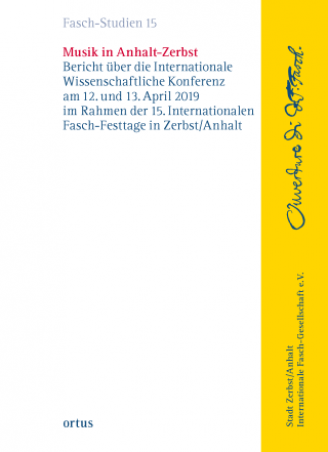Bericht über die Internationale Wissenschaftliche Konferenz am 12. und 13. April 2019 im Rahmen des 15. Internationalen Fasch-Festtage in Zerbst/Anhalt
Edited by Barbara M. Reul and Konstanze Musketa
374pp, ISBN 978-3-937788-61-6 €39.50
Click here to buy this book from the publisher’s website
It seems appropriate on the 322nd anniversary of the composer’s birth to review the latest in a series of conference reports that have enriched our knowledge and understanding of Johann Friedrich Fasch’s life and works. Personal circumstances meant I was unable to attend the conference (which, as regular readers will know, is part of a festival in which music pertinent to the many papers is often performed) so I am doubly glad to have received a copy of the book, packed as it is with new information.
Jan Stockigt produced evidence of a previously unknown trip to Leipzig that Fasch made in 1738; records that survive for those entering through the city gates have survived and amongst many other gems and snippets about musicians and royalty attending the annual fayres was a note of Kapellmeister Fasch entering with a Pastor Voigt. Possible reasons for the trip are suggested that would tie in with payments from court coffers, but Stockigt suggests that among the many thousands of unread documents in the various Dresden archives more evidence may yet be found.
After editor Barbara M. Reul‘s key address in which she produced a vast quantity of new information about musicians active within the court of Zerbst and the Anhalt lands over which it ruled, Maik Richter discussed the 1717 celebrations of the anniversary of the Reformation. Then came my own paper which presented new evidence of musical activities in the 16th, 17th and 18th centuries, including two unknown musical inventories revealing the extent of music-making in the earlier period, three new printed texts for cantatas performed in the Bartholomäikirche (which functioned until 1719 as the court chapel) in 1718 and identifying several of the sources of music performed in the new palace chapel from 1719-1722 when Fasch arrived. Amongst the music performed were two cycles of cantatas by Johann Philipp Krieger; several texts from those three years were repeated in later cycles, including the so-called “Dresden” cycle – that lends support to Marc-Roderich Pfau’s theory explored at a previous conference that the cycle may have been compiled in Zerbst.
Gottfried Gille – whose Fasch-Repertorium (a comprehensive list of Fasch’s religious music) has just been updated – explored in great detail the palace chapel diaries for the church year 1735-36, identifying preachers, establishing the standardised service structures, and exploring non-liturgical texts used in non-Sunday services. Marc-Roderich Pfau‘s second article on cantatas for Apostle Days (something of a Zerbst curiosity) revealed that these were only performed when the date of the feast fell on a Saturday or a Sunday; this explains why Fasch set the texts twice – as the music would be needed in consecutive years, it had better be different (Fasch used and re-used the same cycles throughout his career).
After Stockigt’s paper, Rashid-S. Pegah delved into music in Jever, a town in the north of Germany that fell under the control of Anhalt-Zerbst when the last ruler died without issue. Painting a rich picture of an active musical scene, Pegah also found music by various cantors and other applicants of the job. Like his 2017 paper, this is packed with information and will take weeks to absorb.
The following two papers concerned dancing and more specifically dancing masters in Zerbst. Hanna Walsdorf and Tatjana Schabalina took different approaches; the former concentrated on archival documentation for her portrait of the Hoftanzmeister Anton Albrecht Borckmann and suggested music for dancing might be staring us in the face in many of the Jever music sources (as well as Fasch’s orchestral suites – of which I am rather sceptical), while the latter presented a treatise by Gottfried Taubert that she discovered in the National Library of Russia in St Petersburg.
The next two neatly paired papers concerned the bassoon; Ursula Kramer discussed Johann Christian Klotsch, a virtuoso on the instrument who played in the Zerbst Hofkapelle for over two years until 1736 before moving to Darmstadt (where Fasch’s former prefect, Christoph Graupner, was Kapellmeister). while Klaus Hubmann described Fasch’s music for the instrument and the type of instrument it was most likely played on.
Samantha Owens paper was not directly related to Zerbst but was nonetheless relevant; for years, much of what we know about the activities of boys in court music-making has been (with the exception of Ralph-Jürgen Reipsch‘s 2015 article on a boy soprano from Magdeburg whom Fasch seems to have tried to attract to the Hofkapelle) confined to names and passing references; Owens uses documentation from other Lutheran courts to build a compelling picture of the life of choirboys in the first third of the 18th century.
For those of us who are desperate to understand Fasch’s day-to-day life, Paul Beckus‘s contribution is very valuable; he lists the noble families who held positions at the court and explores the concept of “representation” (i. e., the way princes projected their importance to others), of which the musical establishment was very much part. The final paper by Annegret Mainzer is a survey of musicians from Anhalt who worked in Russia during the second half of the 18th century, a by-product of the marriage between the two courts and the crowning of Catherine the Great (formerly a princess in Zerbst).
So no new musical manuscripts were discovered and only two papers that were really about Fasch at all, but there is still much to learn about the man and his music, and there remain many unturned pages in the archives that will reveal more and more. Let us hope that in the post-COVID-19 world, there is still room for Fasch festivals and Fasch conferences!
Brian Clark
